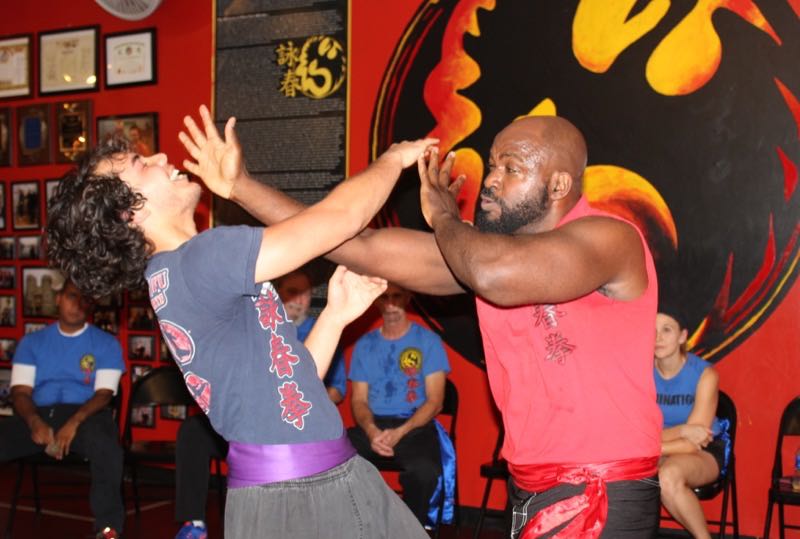If you had to move some furniture, two friends definitely come in handy. What if you were painting a house? Two more painters would make things a lot easier. If you’re in a fight, wouldn’t it be nice if you had the ability to use three of your “weapons” simultaneously as opposed to one? With Wing Chun stances and rooting this is possible. After all, fighting three against one always presents an advantage.
When you’re in a fight you need to take every advantage possible. With many popular styles (Tae Kwon Do, Karate, and boxing, for instance) only one hand or leg is used for attacking (generally speaking). In Karate and Tae Kwon Do the back hand is kept chambered by the side ready to be brought back into the fight with either another strike or block. In boxing, it is kept close to the chin to protect the body and head. One punch is all it takes to end a fight sometimes, but that punch could go either way. Leaving one entire side open to attack is a very dangerous gap in your defense. To keep both hands in the fight, Wing Chun keeps the whole body facing forward. This also gives you the ability to combine strikes, blocks, and counters with a shadow kick or half crescent kick.
Fighting Three Against One – Limbs, That Is
A common combination of all three would be a Tan Sao punch and half crescent moon kick. This is typically utilized to counter an attack from the outside (i.e. a boxing cross moving diagonally across the body). It uses one hand to block the attack, one had to punch the face, and the kick is placed in the ribs. With all three tools being used, the attacker has now been completely caught off guard. Not only has their attack been nullified, they have been knocked off balance with the punch and potentially have broken rib from the kick. With the entire body lurching forward as one unit, a flurry of devastating attacks can be used to follow up.
“If you have an army, why pull away 2/3rds of it during a fight? Keep your whole army ready at all times.”
– Master Sifu Justin Och, Sifu Och Wing Chun
Having the mentality of keeping all weapons forward keeps them readily available which helps decrease reaction time. Since all three weapons can—and should—be used, it makes reacting to an attack easier. Even if you aren’t fully confident with your technique or reaction ability, having all three weapons primed to be activated can greatly increase your chances of defending an attack.
More Than Being Ready
But having the weapons ready is not enough, however. They must be combined with forward intent. A Tan Sao is completely ineffective in stopping a punch if it is not pressing forward to match the incoming energy from the strike. So it is with all of the Wing Chun techniques (with a few specific exceptions).
Seeking to press forward on an attack to disrupt structure lets you attain a direct route to the centerline. Reverting back to the Wing Chun rooting and stance, the hips must be facing forward. They should fuse with the entire torso so as to move as one unit. If the attacker moves, the entire torso is rotated or “shifted” to face the attack. Much like the stance of a shooter, the weapon is not held to the side if a new target appears. The shooter turns his whole body and keeps his weapon in his center.
When the Wing Chun stance is combined with this fighting three against one style, any attack can be withstood, and countered. That’s three times the reaction ability, three times the coverage, and three times the chance of surviving an attack.



